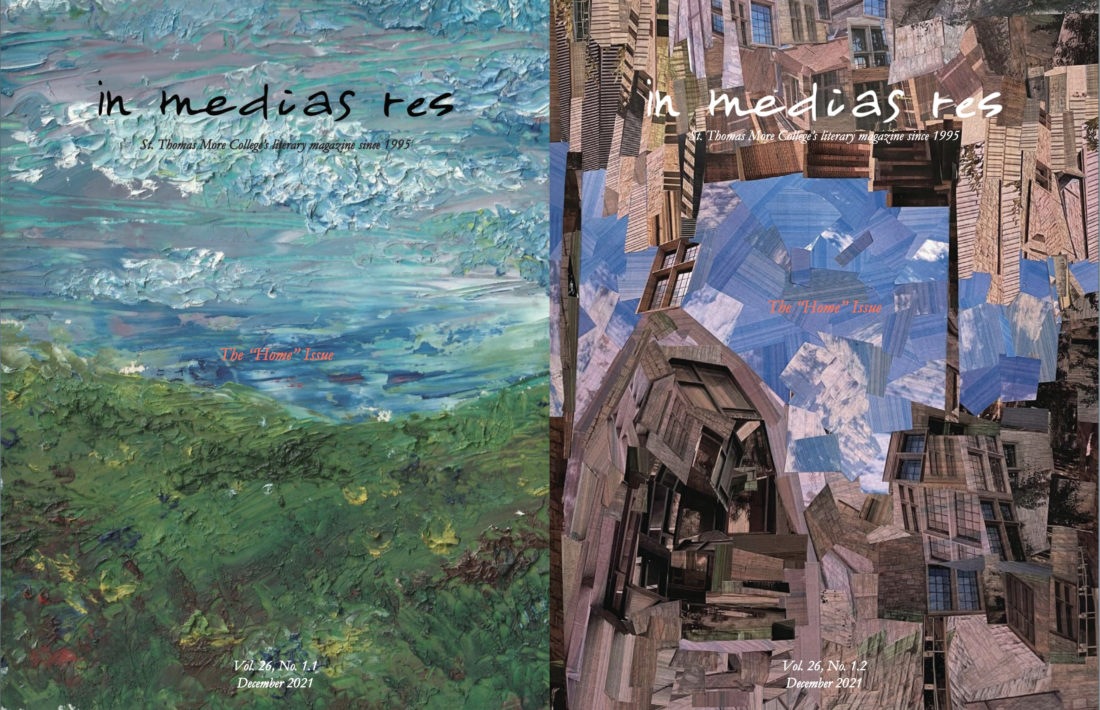
St. Thomas More College’s student-led literary magazine, in medias res, released its first-ever double issue on Dec. 3.
Although much of the editorial process was carried out remotely, the University of Saskatchewan magazine received 71 submissions from volunteers — the most since its inception in 1995. Students of all programs, alumni and staff members submitted artwork, poetry, fiction and nonfiction writing under the theme “home.” These works make up the latest issues, Home 1.1 and Home 1.2, now published on the in medias res website.
Olivia Kerslake, the non-fiction editor at in medias res, says that the “overwhelming” number of submissions were best captured in separate issues to reflect the contrasting answers volunteers gave when asked what “home” means to them.
“As a team, we discovered that there [were] two conflicting ideas that were coming [across]. So there was the cozy feeling of home, and then there was the kind of lost and longing feeling of not having a home,” Kerslake said.
Home 1.1, as explained by Editor-in-Chief Hannah Tran in the issue’s editor’s note, “shows home as a comfort.”
Chloë Hunchak, a fifth-year student majoring in French, was one of 15 volunteers whose work is showcased in “Home 1.1.” Hunchak’s piece “frog songs,” published under the pen name “Chloë Adriana,” was named the best piece in the nonfiction section by the editorial board, winning a $25 honorarium as part of a new initiative by the board to recognize the time volunteers dedicate to their work, according to Tran.
In “frog songs,” Hunchak recounts her experiences of the past summer working away from Saskatoon, in a forested location farther north. In it, she reflects on the places that felt like home to her during this time, despite the distance from her mother’s home.
Hunchak, whose mother immigrated to Canada from Jamaica and whose father is Canadian-born, says that she lacks a concrete definition of home partly because of the uncertain relationship she has with her parents’ respective cultures.
“I’ve had a hard time figuring out what home is to me, because I don’t really feel connected that much to Canadian culture. I’m still kind of figuring out what [home] is for me in my 24th year living,” Hunchak said.
“Home 1.2” features the work of 15 additional writers and artists who “engage the woes of constructing a home,” as Tran explains in the editor’s note.
“Themes of colonialism, longing, diaspora, racism, struggle and a lack of roots haunt these pages, juxtaposing the comforting intimacy of 1.1,” Tran writes.
One of the submissions for “Home 1.2,” written by Eunice-Grace Domingo, a fourth-year honours English student, is the piece “Foster.” This fictional short story describes the complex relationships between a mother, a father and their two children, one of whom is adopted.
Domingo says the story is a “commentary on what really counts as family. Is it blood? Is it relationships? Is it love?”
“I kind of wrote it thinking about family because, when I was in high school, I thought about family a lot. When I was seven, we moved here from the Philippines, and I didn’t know that it was going to be permanent. I thought it was a vacation,” Domingo said.
At the time Domingo wrote “Foster,” numerous relatives and childhood friends of hers, whom she had not seen since leaving the Philippines, had passed away. She says this caused her to contemplate what makes a family.
Of the 30 writers and artists featured in both issues of “Home,” Kerslake says there were “people from all different walks of life, with all these different takes on the subject.”
Kerslake herself contributed two oil paintings of Saskatchewan landscapes to “Home 1.1.” These include the cover art, wildflowers and living skies, and the piece on the south saskatchewan.
“For me, home is all about the nature around us. But, obviously, as we can see in the second issue, for some people home can be like a feeling of loss and helplessness,” Kerslake said.
“So it kind of all just depends on your perspective, I suppose.”
—
Potential conflict of interest: Copy Editor Hannah Tran is the Editor-in-Chief for in medias res and Staff Writer Annie Liu is the Fiction Editor for in medias res. Neither contributed to this article and the article topic was selected independently of their involvement with in medias res. All writers and editors directly involved with the article report no conflicts of interest.
Sandra LeBlanc | News Editor
Photo: Sandra LeBlanc | News Editor